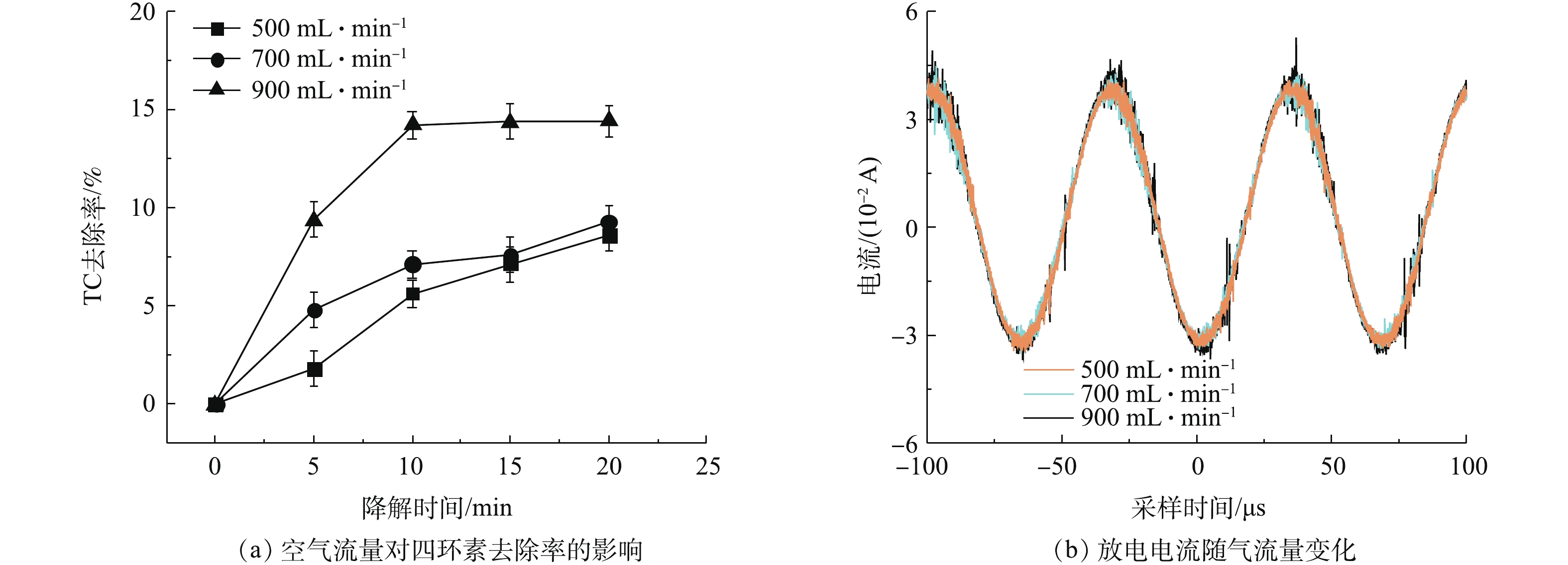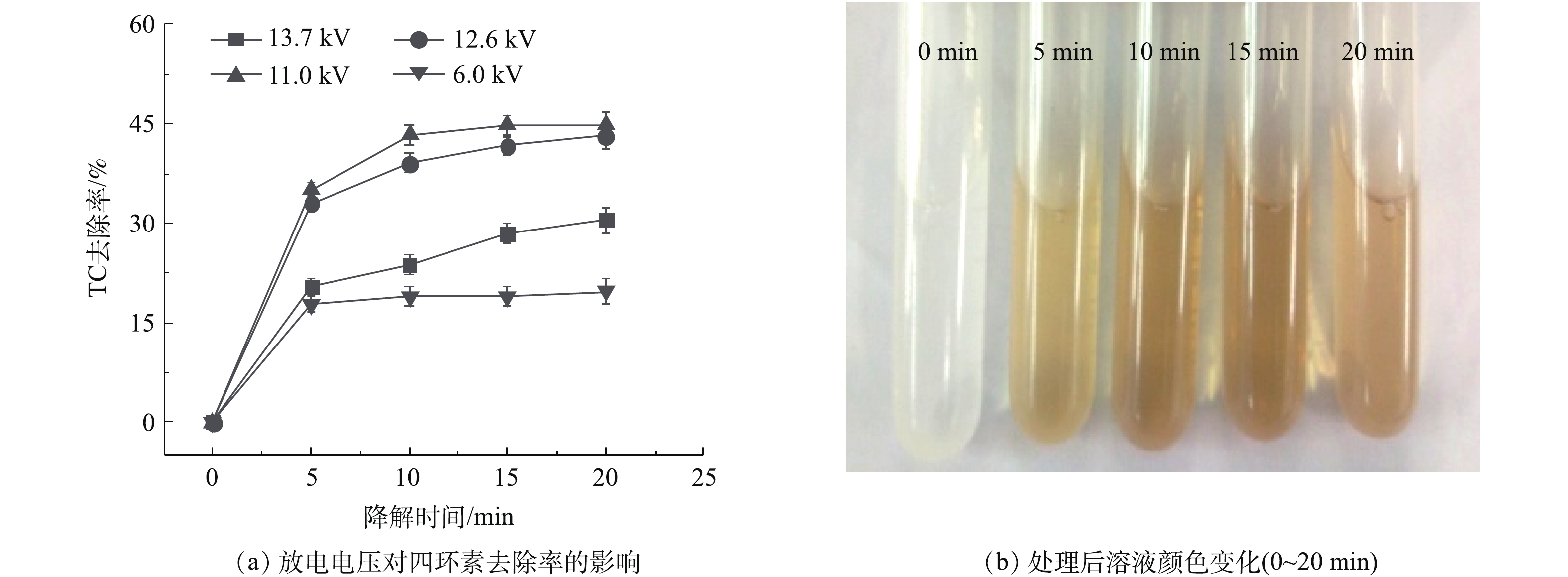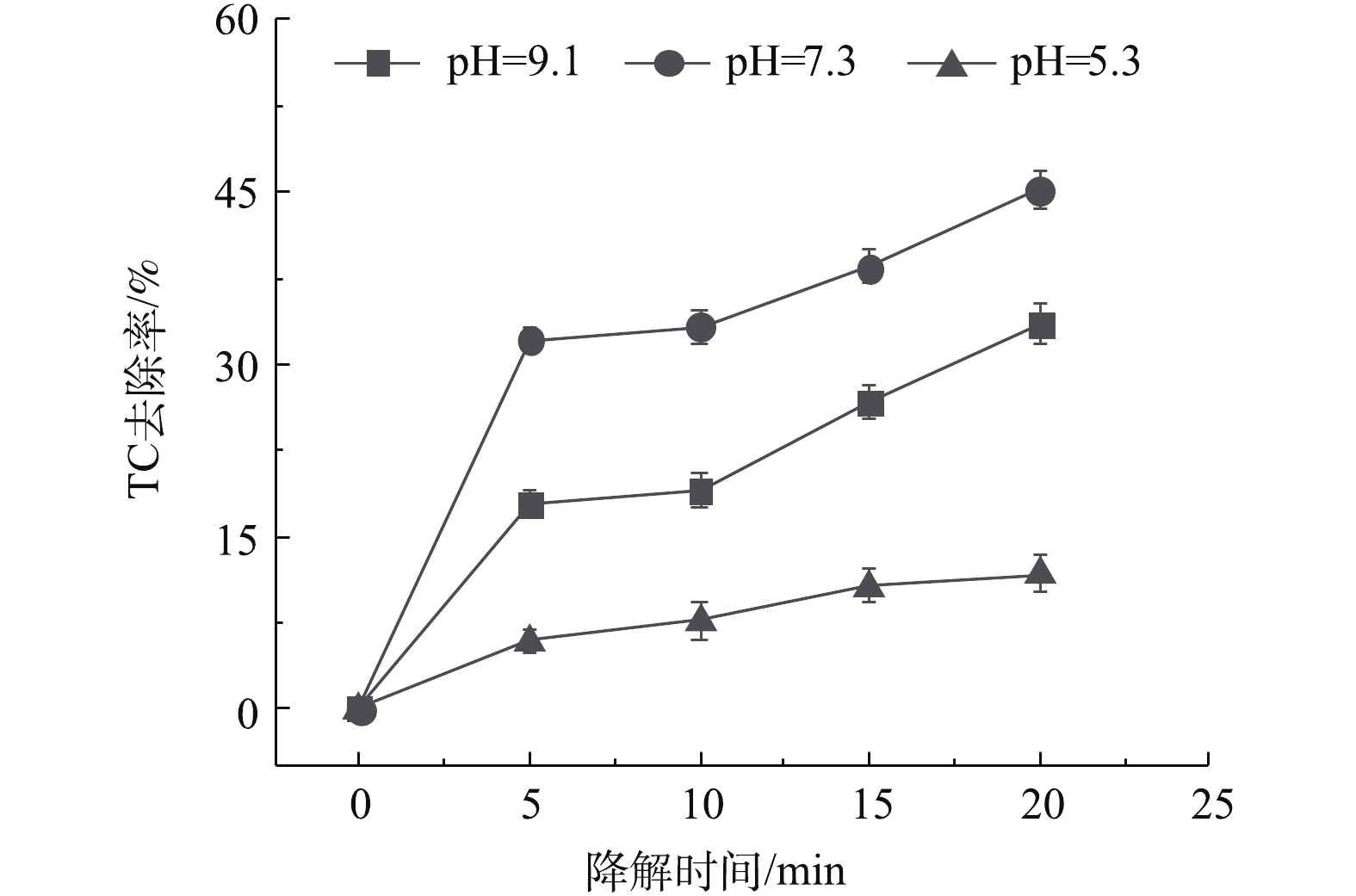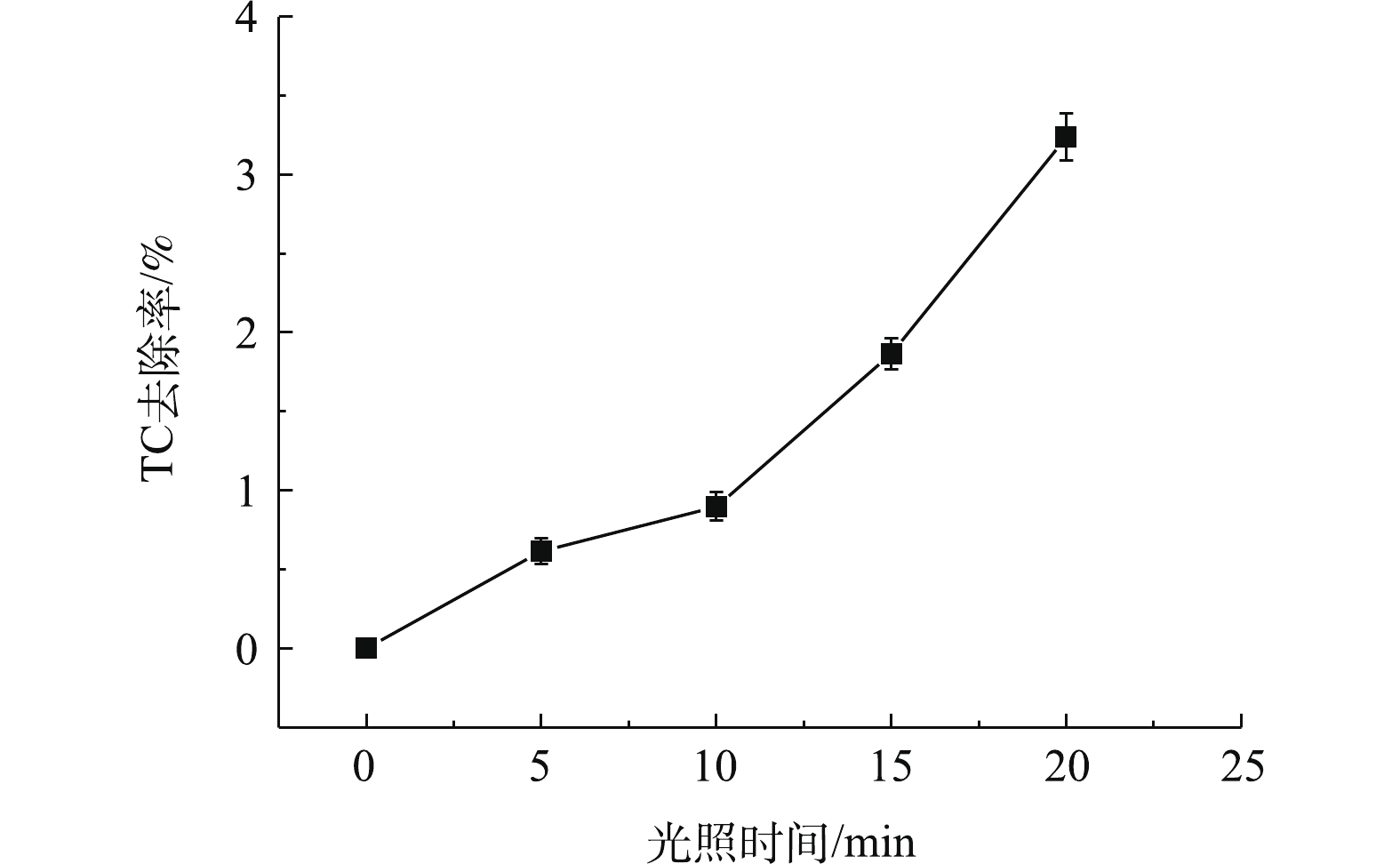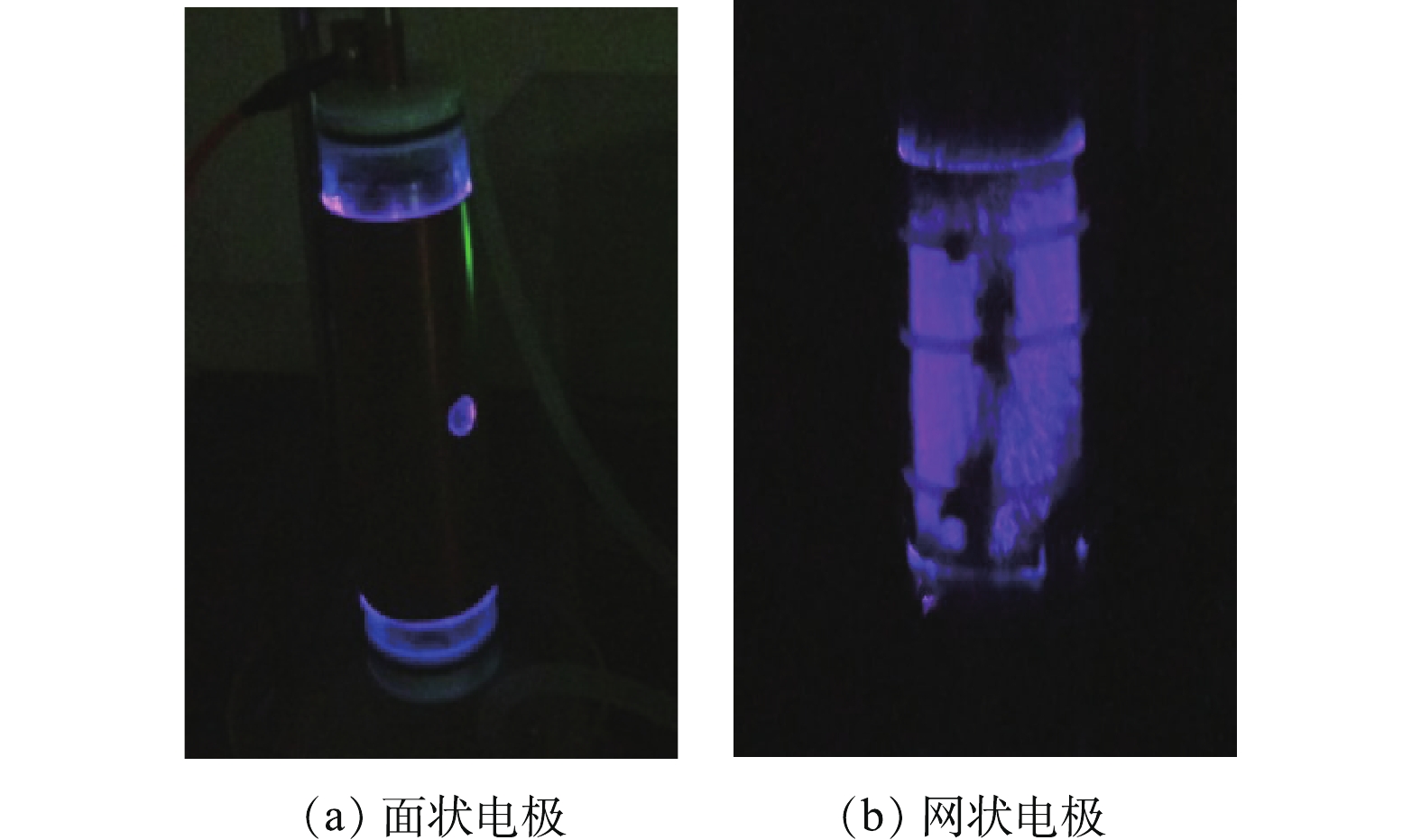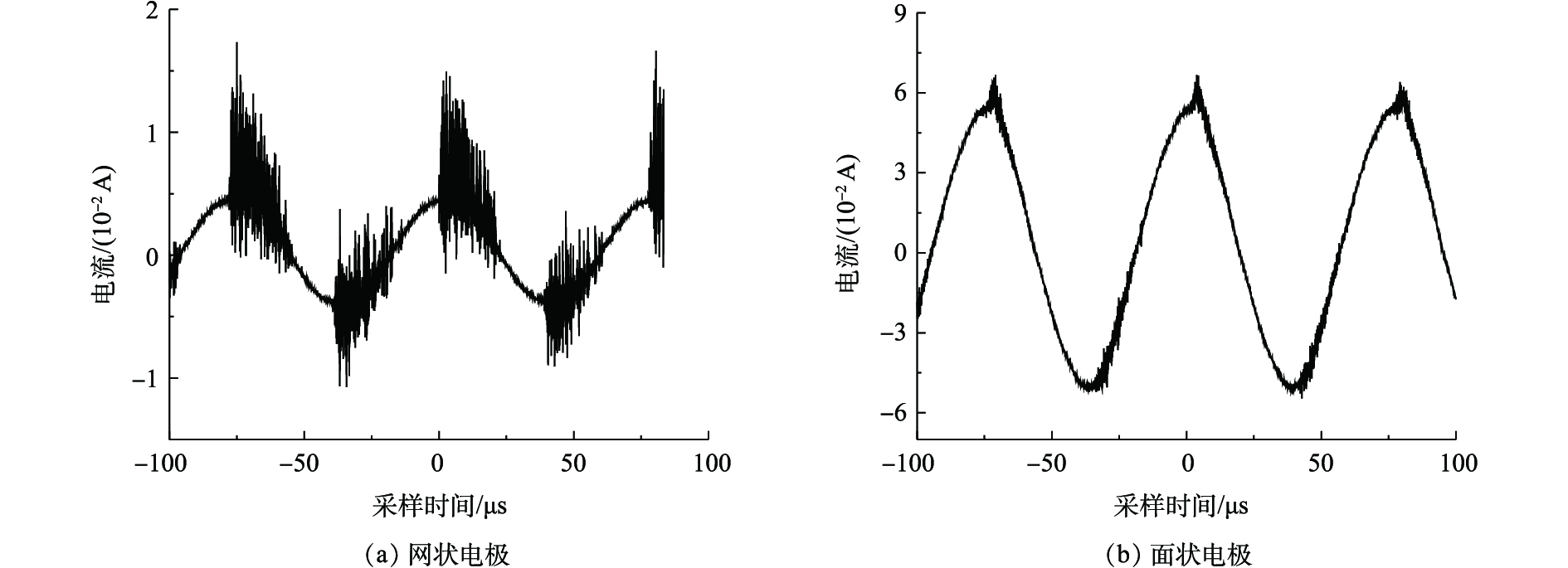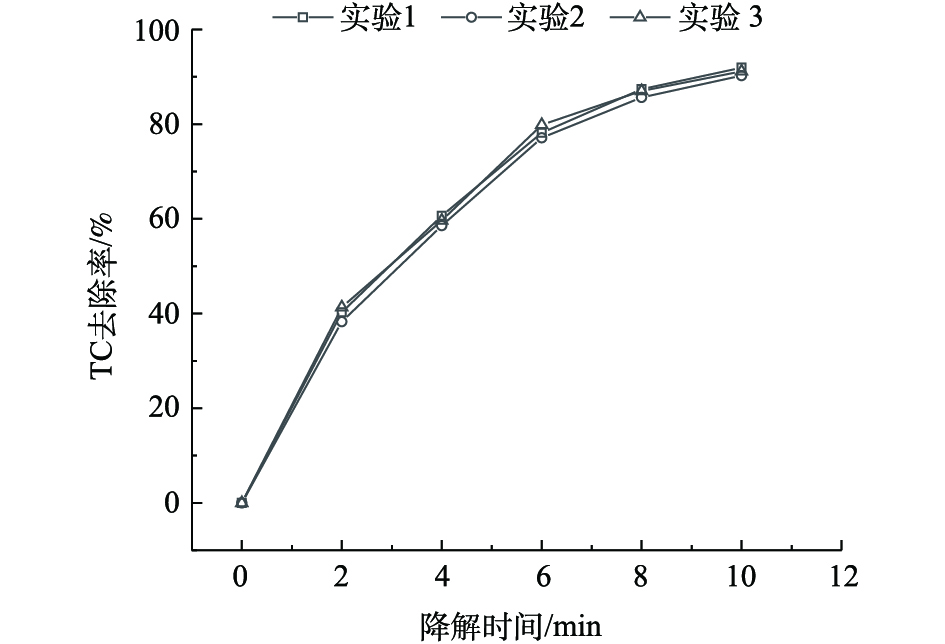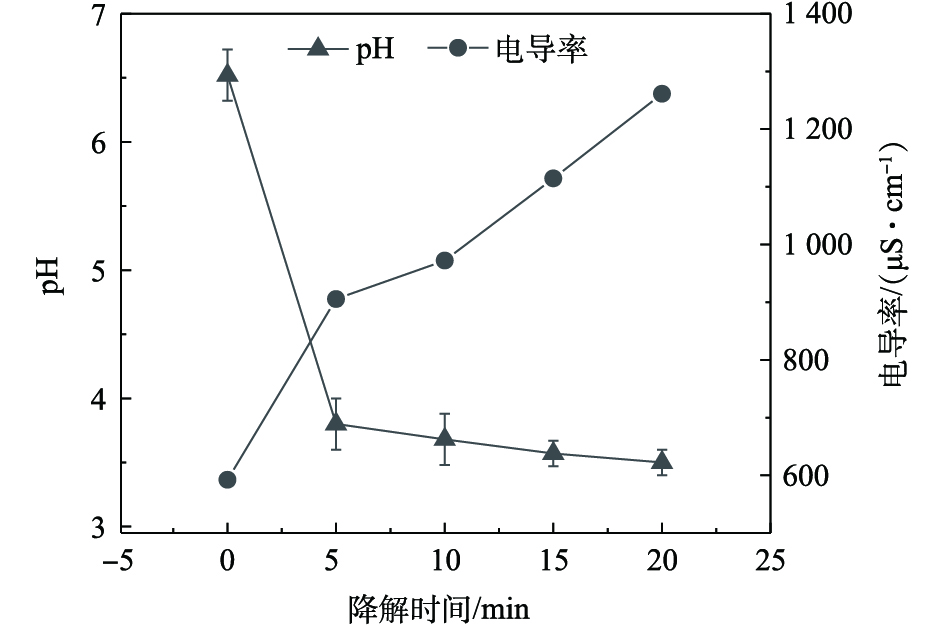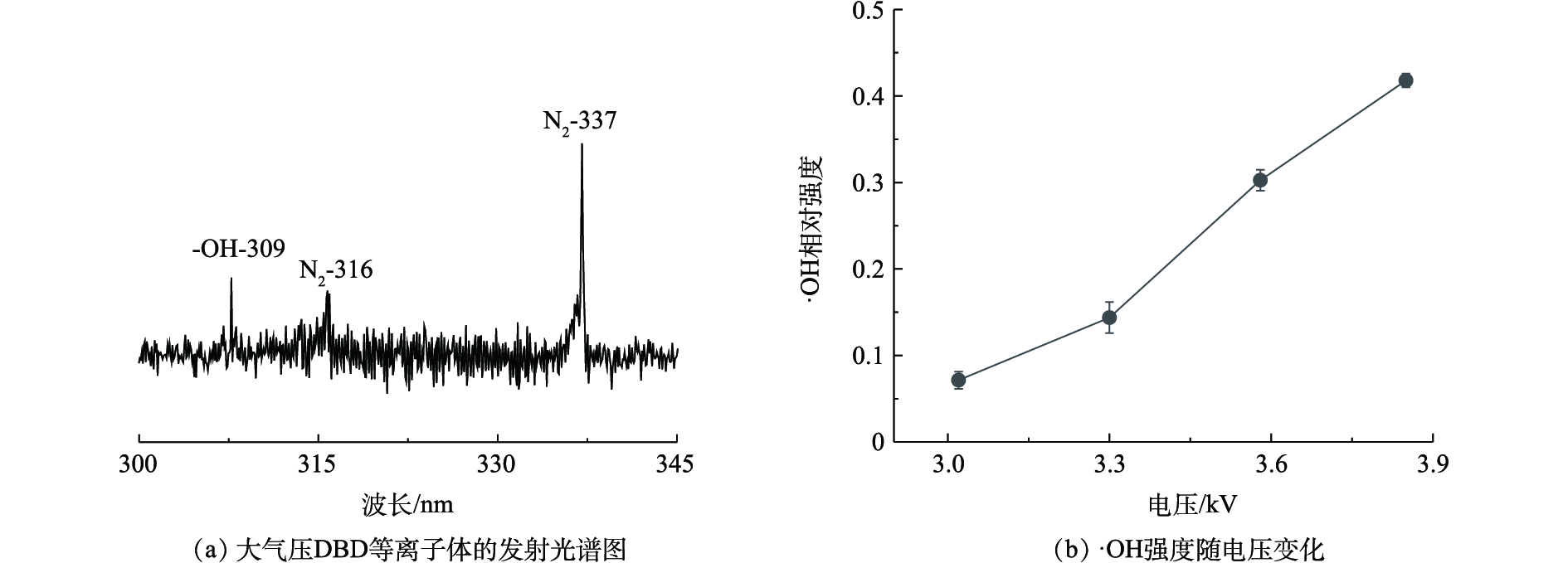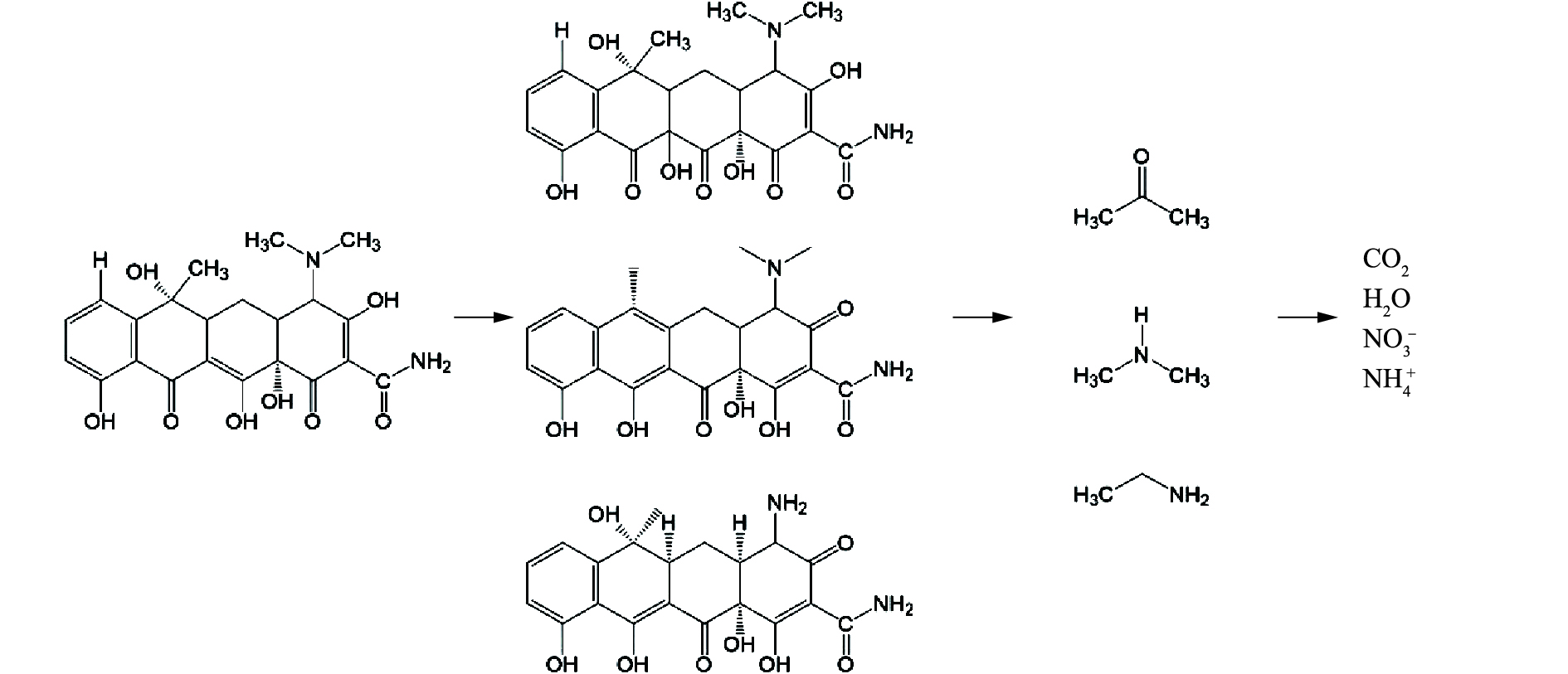-
近年来,随着社会的发展和人们日常生活水平的提高,人体和动物对抗生素药品使用量不断增长。抗生素的普及使用带来便利的同时,其对水体的污染问题不容忽视。抗生素类药物进入水环境,危害水中生物以及污染人类的生活用水[1-2]。面临日益严重的水质问题,亟需研究出高效、经济的抗生素污染水处理技术。
高级氧化技术(advanced oxidation technology,AOP)包括臭氧、光催化、Fenton氧化法和非热等离子体技术[3],已被证实可以降解废水中的抗生素。关于臭氧化降解[4]的报道,BELTRAN等[5]采用臭氧对水中磺胺甲恶唑进行处理,KUANG等[6]研究甲氧苄氨嘧啶在水溶液中的臭氧氧化过程,发现总有机碳(total organic carbon,TOC)去除率较低(10%和0)。光催化降解法[3]对微量有机抗生素的去除有明显的优势。但整个体系对光能的吸收和水体的透光性均有特定的要求,限制了其大规模应用。Fenton氧化法对反应体系的pH要求较高,且对过氧化氢的利用率较低[3-4, 7]。以上方法在应用上均有不同程度的限制和问题[8]。非热等离子体技术通过放电形成的高能电子、离子、活性自由基、激发态原子和分子等参与化学反应[9],同时产生光、热、电等物理效应,共同作用降解废水中的抗生素[3, 10-11]。电晕[11]、辉光[1]、滑动弧[12-13]及介质阻挡放电(dielectric barrier discharge,DBD)等都是有效降解水中有机污染物方法[14-15]。DBD设备通常可形成较大面积均匀放电,在操作和控制方面具有明显优势[16],介质层可防止形成局部火花或者弧光放电,使运行安全稳定,从而被广泛的应用。
目前,DBD放电装置应用于水处理时,主要采用针-板式、线-板式以及环-筒式等结构[16]。本研究通过进一步改进同轴-圆筒式大气压降膜[17-18]DBD反应器,反应器有效放电面积较大,与从前的等离子体降解研究[19-25]相比,可处理废水的体积增多,并且与循环下降水膜有较大接触面,更有利于氧化物种从气相到液相的良好传递[25-28]。本研究探究了反应体系中外加电压、气体流量、液体流量、初始pH及电极结构等参数对四环素降解效果的影响,同时检测了降解过程中不同时段的pH和电导率变化,通过UV-vis光谱和高效液相色谱-质谱对中间产物的表征,推测出四环素降解的可能反应过程和降解机制。研究结果为实现大面积、工业级的有机抗生素废水的处理,保护水生生态环境提供参考。
全文HTML
-
实验仪器:电源CTP-2000K(南京苏曼),pH采集通过PHSJ-3CT型pH计(雷磁-上海仪电),采用DDS-307型电导率仪(雷磁-上海仪电)测量溶液电导率变化,采用COD分析仪(上海仪电)分析化学需氧量的变化,使用LZB-4型玻璃转子流量计控制进气量,使用Cary 100紫外-可见分光光度计(岛津)和SB-438Y LC-60A型高效液相色谱仪对溶液成分进行检测。
实验试剂:四环素(tetracycline, TC)购于北京华力德科技有限公司;采用浓度1 mol·L−1 NaOH溶液和HCl调节溶液pH,均为分析纯;配制TC溶液用水为去离子水。
-
实验装置的构建根据本研究组之前的研究[29],如图1(a)所示,实验在同轴DBD反应器中进行,溶液在内部高压电极表面流动成膜,放电发生在气体(空气)和溶液之间的界面。放电间隙3 mm。放电特性通过示波器(Tektronix DPO4014)测量,采用Tektronix P6015A高压探头和Tektronix T CPA 300电流探头分别测量放电电压和电流。
电源参数:电压为0~30 kV,频率为8~40 kHz,中心频率为20 kHz,额定功率为500 W。图1(b)和图1(c)是放电时电压-电流波形,电流波形是DBD电容结构产生的位移电流[30]与放电的脉冲电流的叠加。可以看到,电流脉冲密集,幅值较小,波形较为稳定[31-32]。
-
将150 mL浓度为100 mg·L−1的四环素水溶液(pH=7.3)置于反应器中,待装置内气体和液体运行稳定后,启动电源,形成等离子体对水样进行处理。处理过程中,每隔2~5 min取样1次,取样体积为5 mL。模拟废水中四环素的剩余浓度用紫外分光光度法测定(357 nm)。根据式(1)计算四环素的去除率。
式中:η为去除率;C0为初始TC浓度,mg·L−1;Ct为t时TC溶液浓度,mg·L−1。
能量效率和放电中的平均功率是通过对电流和电压波形的测量,并按照式(2)和式(3)计算。
式中:E为能量效率,g·(kWh)−1;P为平均功率,W;T为电源周期,μs;f为电源频率,Hz;I为电流,A;U为电压,kV;V为溶液体积,mL;t为等离子体处理时间,min。
色谱检测条件:Luna C18(2)色谱柱(4.6 mm×250 mm, 5 μm);柱温为35 ℃;乙腈和去离子水作为流动相,流速设置为1.0 mL·min−1;批量进样体积10 μL。化学需氧量(chemical oxygen demand,COD)采集和测量通过快速消解-分光光度法(HJ/T 399-2007)进行。紫外光照实验:取100 mg·L−1 TC溶液150 mL置于石英玻璃皿中,将紫外灯(功率为500 W)置于石英皿正上方,垂直放置,光源与溶液距离2 cm。照射时,每5 min取样一次,照射时间为20 min。
实验过程中,在固定的间隔时间(2 min或5 min)内取样,以分析废水中四环素溶液的浓度和中间产物。
1.1. 实验仪器与试剂
1.2. 实验装置
1.3. 实验步骤与分析方法
-
在四环素初始浓度为100 mg·L−1,放电电压为6.0 kV,实验处理时间为20 min时,考察了TC去除率随空气流量的变化(图2(a))和放电电流随气流量变化(图2(b))。由图2可见,随着空气流量的增多,TC的去除率升高;I-t曲线上叠加的电流脉冲数量增加,脉冲幅度变高。其原因为:当反应器中通过放电区域的气体量变大时,形成等离子体放电通道增加,整体放电更剧烈,放电生成的活性粒子增多,导致四环素的去除率增加[16]。此外,气体的击穿电压较液体小,更容易放电,空气流量的增加,放电生成的更多活性粒子可以高效地与溶液接触,提高了TC去除率。因此,适当增加气体流量有利于TC去除率的提高。
-
图3(a)反映了初始浓度100 mg·L−1的TC的去除率随输入电压的变化。实验处理20 min,当输入电压为11.0 kV时,四环素的去除率可达到44.8%,电压为6.0 kV时,去除率仅为22.8%。图3(b)为电压11.0 kV时,放电时间和处理溶液颜色的关系。可以看出,处理5 min后,TC液体由无色逐渐变成淡黄色,20 min后,变成深褐色。随着处理时间的增加,四环素逐渐被降解,生成了新的物质,同时部分产生矿化,这导致溶液颜色由无色逐渐变成淡黄色,变成深褐色的过程[33]。
在放电过程中,随着输入电压的增加,电极间电场强度相应増大,形成等离子体通道数目增多,电子能够获得更高的能量,进而由电子轰击产生的活性氧化物种量也增加[11, 34]。而当电压继续增加到12.6 kV和13.7 kV时,TC去除率相比电压为11.0 kV时有所降低,分别为40%和30%,其原因为:当输入电压进一步增大,气相产生的活性物种浓度过高,导致产生速率趋于饱和,扩散到液体内的反应基团浓度增加不明显;同时,放电功率增加,过高的电能会部分转化为焦耳热,致使反应器内的温度过高,通过测温发现,电压为6.0、11.0、12.6和13.7 kV,放电20 min后,溶液温度分别从室温(25 ℃)升高到30、43、59、64 ℃,即电压升高后,转化的热能增加,致使作用于降解TC的有效功率降低,导致高电压下四环素去除率降低,同时温度过高,会降低等离子体产生的H2O2和O3等活性物质寿命,使其与TC的反应时间缩短[34-35];并降低其溶解度,降低了液相中活性物质浓度,这些都不利于四环素降解,从而降低了四环素的降解率。
-
溶液初始pH的大小通常会决定各物质的离解程度和离子属性,影响溶液的电导率,改变电解反应及各种附属反应的发生方向[36]。由图4可知,在电压11 kV、处理时间20 min,调节TC(初始浓度为100 mg·L−1)溶液的初始pH分别为5.3、7.3和9.1时,得到对应的TC去除率分别为11.7%、45.2%和33.5%;当溶液pH为7.3时,去除率较高。产生这种现象的主要原因:一方面,在弱碱性溶液中存在适量的OH-,有利于臭氧分解产生·OH[11, 16],加快了四环素的降解速率[11];另一方面,四环素自身在碱性环境下不稳定,更趋向于分解[14]。
而当pH较高(pH=9.1)时,羟基自由基之间淬灭反应逐渐增强[11],导致·OH浓度降低,降解效率降低,TC去除率下降为33%,并且在实际废水处理中,通常以中性条件为基础。因此,选用弱碱性环境,即pH为7.3时的去除效果最佳。
-
在四环素溶液初始浓度为100 mg·L−1、放电电压为11 kV的条件下,实验处理20 min,四环素去除率随液体流速的变化如图5所示。当蠕动泵流量从727 mL·min−1增加到1 000 mL·min−1时,四环素去除率逐渐增大,流量为1 000 mL·min−1,去除率为52.1%。循环流量决定废液单位时间处理次数[10]。在循环流量较高时,一方面会使得液膜均匀性增加,放电会趋于稳定,放电产生的自由基和活性粒子能充分接触液膜,高能电子、自由基等活性物质对溶液作用增加;另一方面,较高的流速也使得液体在反应器中单位时间循环次数增加,增加等离子体对污染物作用次数,使更多的活性物种与四环素反应,导致四环素的去除率总体呈递增趋势。
-
通过四环素去除率随紫外光照时间变化的对比实验,可以排除四环素的降解可能是由等离子体产生的紫外光所致,实验结果图6所示。由图6可知,随着光照时间的增加,四环素的去除率略有升高,但总体去除率仍较低。并且放电产生的紫外光远小于紫外灯的光强,实验处理20 min后,四环素去除率仅为3.2%。因此,在降解四环素的过程中,等离子体产生的紫外线对四环素降解的影响可忽略不计。
-
研究了面状电极和网状电极2种外电极结构对四环素降解的影响。图7为2种电极条件下放电照片,可以看出,到在面状电极为外电极结构下,放电区域较小,集中在电极上下2个部位以及中间小孔边缘,放电较弱,发光较暗且局部;而当外电极为网状时,放电充满整个放电管,放电发光较为均匀、明亮。图8为2种外电极结构的放电电流波形。可以看出,采用网状外电极后,电流脉冲数量急剧增加,脉冲幅值明显增大,放电显著增强。
通过采用面状和网状电极对TC(初始浓度为100 mg·L−1)处理效果进行了比较。图9(a)为面状电极,外加电压为11 kV时,去除率随时间的变化;图9(b)为网状电极,外加电压为3.85 kV时,去除率随时间的变化。从图9中可以看出,2种电极对TC的去除率均随时间的增加而升高。面状电极在处理电压11 kV、处理时间20 min的条件下,TC去除率可达52.1%,能量效率可达1.63 g·(kWh)−1;而网状电极在处理电压为3.85 kV,处理时间为10 min的条件下,TC去除率可达92%,,能量效率可达3.16 g·(kWh)−1,这说明网状电极显著提高了TC的去除率。由图8可知,采用网状电极放电微通道显著增多,且放电强度有所增加。微放电通道内的电荷传输量决定着处理效率[37],放电空间的微放电通道增多,传输的电荷量也相应增多,参加反应的等离子体就更加充分,活性粒子的分散程度更趋于均匀,能充分接触被处理液膜,故采用网状电极更有利于污染物的去除。图9(c)为在网状电极条件下外加电压对TC去除率的影响。可以看到,采用网状电极时,TC去除率随着电压增加而增大。电压为3.85 kV时,处理10 min时,TC去除率可达到90%以上。这种较高的去除率是因为放电得到了改善,激发产生的活性粒子浓度增加所致。
王辉等[38]的研究中也强调采用网状电极的重要性。对于面状外电极,放电主要集中于电场较强的面状边缘以及中间小孔边缘。边缘处电场强度梯度过大,放电均匀性很差,结果是四环素的去除率较低。采用网状电极,放电分布于整个外电极上的网孔处,而不是集中于上下边缘处,内外电极间的场强梯度变小,放电均匀性大幅度提高。因此,使用网状外电极时,有效等离子体作用区域加大,与液相的接触面积有所增加,四环素去除效果得到增强。
-
为考察其反应过程的稳定性,在外加电压为3.85 kV,处理时间为10 min的条件下,采用网状外电极进行3次重复实验。图10为TC去除率(初始浓度为100 mg·L−1)随时间的变化。由图10中可知,3次实验中TC去除率变化趋势基本一致,同一测量时间点的去除率标准偏差(1%~3%)较小,在处理时间为10 min时,去除率均在91%左右,实验结果说明此降解过程具有较好的稳定性。
-
在等离子体处理过程中,处理液的成分和性质会发生变化。图11为在放电电压11 kV、TC(初始浓度为 100 mg·L−1)溶液流量为1 000 mL·min−1、空气流量为900 mL·min−1、面状外电极处理时四环素溶液的pH和电导率随处理时间的变化情况。可以看到,在反应5 min内,溶液的pH迅速下降,随后变化趋于缓慢。这与上述讨论中pH对去除率的影响结果相一致(图3)。其反应过程涉及的反应[11, 14, 39-42]如式(4)~式(16)所示。通过放电生成的长寿命活性氧物种[42](主要是O3,H2O2(pKa=11.75))的酸性较弱,而空气中的氮在等离子体的作用下形成氮原子,氮原子与氧气发生反应生成氮氧化物,后在溶液中产生大量的硝酸(pKa=−1.3)和亚硝酸(pKa=3.3)以及在酸性条件下形成过氧亚硝酸等,活性氮物种的形成同时又消耗了大量的氧气,限制了活性氧物种的形成,导致了溶液的pH快速降低。但是,随着处理时间的延长,四环素降解生成酸性中间产物,易与·OH产生中和反应,pH变化缓慢[43]。此外,TC降解会产生许多酸性产物,也会造成溶液pH下降。
溶液的电导率的增加,不仅因为等离子体和水作用后在溶液中产生大量的硝酸和亚硝酸等活性氮物种,同时降解过程中小分子的不断产生,也使溶液中离子浓度升高,溶液电导率增加。随着处理时间的增加,液体电导率一直在增加。
-
采用发射光谱(optical emission spectrum, OES)对气态等离子体中的粒子进行检测。如图12(a)所示,光谱中出现了波长为309 nm的活性粒子·OH(A2Σ+→X2Ⅱ)的谱线,波长为316 nm和337 nm的N2(C3πu→B3πg)的谱线。观察到光谱中出现了N2(C-B)的跃迁谱带是由空气中的氮气参与等离子体化学反应所致。由图12(b)可以看到,·OH谱线强度随着电压增大而逐渐增强,这表明在高电压和大功率的条件下可生成更多的·OH。
气相中等离子体作用是产生羟基自由基的重要途径之一,羟基自由基对四环素降解起着重要的作用[44]。气相中羟基自由基的浓度升高会增强其从气相到液相的传递,通过气相溶解、扩散或气相等离子体对液面的直接作用等[45-46]转移至液相中,液相中的强氧化性羟基自由基对四环素不断攻击,使其主链断裂、降解。随电压升高,气相反应增强,导致作用于TC的羟基增多,进而增强TC的降解。
-
处理液COD随时间的变化曲线如图13所示,在空气等离子体处理10 min内,随着处理时间的延长,COD去除率逐渐提高,处理10 min后,样品COD为45%。这说明本实验采用的DBD放电不仅可以高效分解四环素,还可以对分解物进行有效的矿化。王保伟等[14]采用DBD降解盐酸四环素,30 min后,降解率可达92%,溶液的COD矿化率为48%;何东等[11]采用针-板电晕放电去除水中四环素,20 min后,去除率为99.1%,COD去除率为31.2%;JIN等[47]采用接触辉光放电降解土霉素(OTC),60 min后,OTC去除率为98.12%,COD去除率接近40%。而本研究结果为处理10 min后,四环素的降解率为92%,COD的去除率为45%。其优势在于能够实现在短时间内快速高效地去除水中TC。
-
图14(a)为四环素在不同处理时间段(0、5、10、15、20 min)的紫外吸收。已知四环素在紫外光谱中表现出2个特征吸收峰,分别位于276 nm和357 nm处。可以看出,276 nm和357 nm处的峰值在反应初始阶段大幅度降低,随着处理时间的延长,对应的吸光度逐步降低,且在276 nm处的吸收峰伴有明显蓝移现象,这说明四环素在开始处理时就发生主链的断裂,导致其分子结构受到破坏[11]。由图14(b)可知,经过12.6 min后,主峰逐渐消失,这也表明等离子体对四环素降解会使其分子主链结构被破坏。对中间产物采用液相色谱-质谱联用仪进行检测和分析(图14(c)),得到的主要中间产物m/z为45、58、416、426、460,推断其对应的产物可能为二甲胺或乙胺、丙酮、N-去(二甲基)-4-表-四环素、脱水差向四环素、土霉素等。
图15为等离子体作用TC降解过程的原理示意图,DBD等离子体首先在气相产生·OH/·OOH/O等活性基团,通过扩散进入液相;通过高能电子碰撞水分子生成的·OH,或发生如式(17)~式(22)的一系列反应[39],产生的活性物质进一步与TC反应,使其降解。
据此推断,四环素降解路线如图16所示。四环素在DBD等离子体作用下首先降解生成N-去(二甲基)-4-表-四环素、脱水差向四环素和土霉素等,随着处理时间的延长,中间产物进一步氧化生成二甲胺、乙胺、丙酮以及有机酸等小分子物质,这些小分子有机物最终会被进一步氧化成为CO2、H2O、
$ {\rm{NO}}_3^{\rm{ - }}$ 、$ {\rm{NH}}_4^{\rm{ + }}$ 等小分子化合物。但是,其准确的降解路径还有待进一步实验检测分析确定。
2.1. 空气流量的影响
2.2. 放电电压的影响
2.3. 处理液初始pH的影响
2.4. 液体流量的影响
2.5. 紫外光光照时间的影响
2.6. 电极结构的影响
2.7. 稳定性实验
2.8. 处理过程中溶液pH和电导率的变化
2.9. 反应器中等离子体的光谱诊断
2.10. 处理过程中化学需氧量的变化
2.11. 四环素降解机理分析
-
1)采用自行设计大容量、圆-筒式大气压降膜DBD等离子体放电装置,可以有效降解模拟废水中的四环素,且等离子体放电参数对四环素的降解均有较大的影响。在四环素初始浓度为100 mg·L−1、气体流量900 mL·min−1、溶液流量1 000 mL·min−1等实验条件下,采用网状电极,处理10 min后,TC去除率可达92%,COD去除率为45%,能量效率为3.16 g·(kWh)−1。
2)实验发现,降解过程中溶液的pH不断降低,电导率升高,可能是放电降解产生的小分子中间产物以及硝酸和亚硝酸等产物引起的。
3)通过对反应器中等离子体的在线光谱诊断,·OH谱线强度随着电压的增大近似线性增强,较高电压下,TC的去除率也相应较高,表明·OH对四环素降解中起着重要的作用。
4)通过对四环素降解过程中的中间产物检测,发现DBD等离子体处理可导致TC的分子主链的断裂。在处理2 min后,生成中间产物为N-去(二甲基)-4-表-四环素和脱水差向四环素。推断DBD等离子体对四环素降解路径为:随着等离子体处理时间的延长,四环素先生成中间产物,再降解生成大量小分子化合物,如二甲胺,乙胺以及有机酸等,最后被氧化生成CO2、H2O、
$ {\rm{NO}}_3^{\rm{ - }}$ 、$ {\rm{NH}}_4^{\rm{ + }}$ 等产物。在经等离子体处理后,水体中四环素能够在短时间内得到高效去除,这有利于实现大规模高效水处理的工业化。




 下载:
下载:
